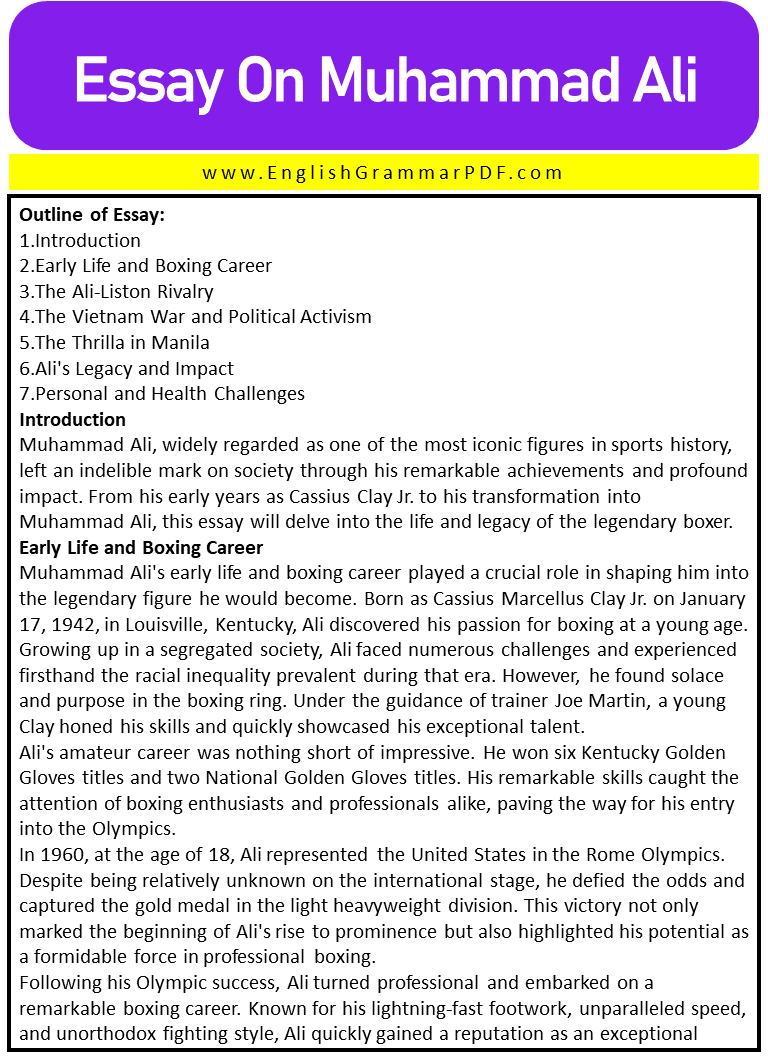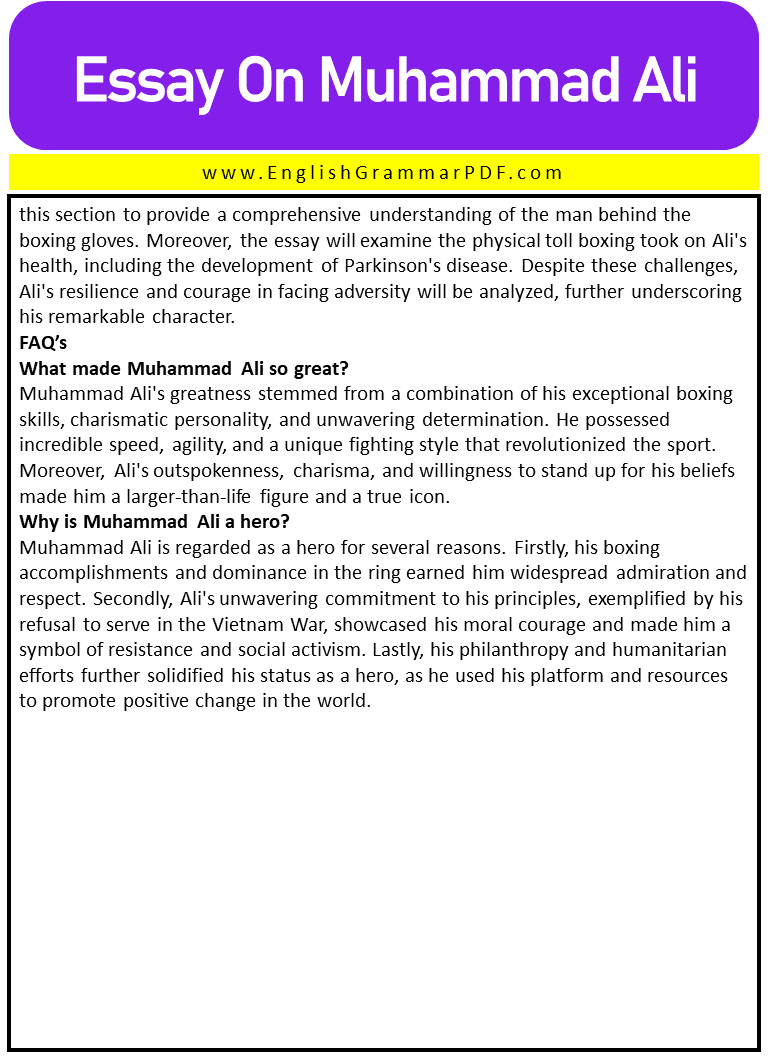Essay On Muhammad Ali
Outline of Essay:
- Introduction
- Early Life and Boxing Career
- The Ali-Liston Rivalry
- The Vietnam War and Political Activism
- The Thrilla in Manila
- Ali’s Legacy and Impact
- Personal and Health Challenges
Introduction
Muhammad Ali, widely regarded as one of the most iconic figures in sports history, left an indelible mark on society through his remarkable achievements and profound impact. From his early years as Cassius Clay Jr. to his transformation into Muhammad Ali, this essay will delve into the life and legacy of the legendary boxer.
Early Life and Boxing Career
Muhammad Ali’s early life and boxing career played a crucial role in shaping him into the legendary figure he would become. Born as Cassius Marcellus Clay Jr. on January 17, 1942, in Louisville, Kentucky, Ali discovered his passion for boxing at a young age.
Growing up in a segregated society, Ali faced numerous challenges and experienced firsthand the racial inequality prevalent during that era. However, he found solace and purpose in the boxing ring. Under the guidance of trainer Joe Martin, a young Clay honed his skills and quickly showcased his exceptional talent.
Ali’s amateur career was nothing short of impressive. He won six Kentucky Golden Gloves titles and two National Golden Gloves titles. His remarkable skills caught the attention of boxing enthusiasts and professionals alike, paving the way for his entry into the Olympics.
In 1960, at the age of 18, Ali represented the United States in the Rome Olympics. Despite being relatively unknown on the international stage, he defied the odds and captured the gold medal in the light heavyweight division. This victory not only marked the beginning of Ali’s rise to prominence but also highlighted his potential as a formidable force in professional boxing.
Following his Olympic success, Ali turned professional and embarked on a remarkable boxing career. Known for his lightning-fast footwork, unparalleled speed, and unorthodox fighting style, Ali quickly gained a reputation as an exceptional athlete. He used his agility and unique approach, which he called “float like a butterfly, sting like a bee,” to outmaneuver and outsmart his opponents.
In 1964, Ali faced Sonny Liston in a highly anticipated bout that would change the course of his career. Despite being considered the underdog, Ali’s confidence and unyielding determination led him to an unexpected victory. This marked the beginning of a series of high-profile fights and rivalries that would define his legacy.
Throughout his boxing career, Ali’s charisma and showmanship captivated audiences worldwide. He became known not only for his boxing prowess but also for his outspoken nature and charismatic personality. His ability to promote and sell his fights made him a larger-than-life figure and a beloved global icon.
The Ali-Liston Rivalry
One of the most captivating chapters in Ali’s career was his rivalry with Sonny Liston. This section will provide a detailed account of the buildup to their historic fights in 1964 and 1965. Analyzing the controversial first fight and Ali’s unexpected victory will shed light on his unconventional boxing style and the impact it had on the sport. Furthermore, the rematch between Ali and Liston, which resulted in Ali’s dominant win, solidified his position as a boxing sensation.
The Vietnam War and Political Activism
The Vietnam War, spanning from 1955 to 1975, was a highly controversial conflict that had far-reaching political and social implications. As the war escalated, it ignited a wave of political activism, with individuals and groups across the globe taking a stand against the U.S. involvement in Vietnam.
The Vietnam War prompted widespread opposition due to its perceived illegitimacy and the staggering loss of human life. Many activists saw the war as a symbol of imperialistic aggression and a violation of Vietnamese sovereignty. They criticized the U.S. government’s rationale for military intervention and raised questions about the moral and ethical implications of the war. The anti-war movement gained momentum, attracting a diverse range of participants, including students, intellectuals, religious leaders, and civil rights activists.
One of the prominent figures who emerged during this era of political activism was Muhammad Ali. Ali, as a devout Muslim, refused to be conscripted into the U.S. military, citing religious and moral reasons. His decision to resist the draft and subsequent conviction had a profound impact on the anti-war movement and sparked a broader dialogue about conscientious objection. Ali’s steadfast stance resonated with many who saw the Vietnam War as unjust, and he became a symbol of defiance against the establishment.
The anti-war movement extended beyond individuals like Ali. Protests, rallies, and demonstrations were held worldwide, with millions voicing their opposition to the war. Activists employed various strategies to convey their message, including draft card burnings, sit-ins, and civil disobedience. The movement’s efforts brought the war to the forefront of public consciousness and forced policymakers to confront mounting public dissent.
The Vietnam War and the subsequent political activism it inspired not only challenged the legitimacy of the war but also raised broader questions about government accountability and the role of citizens in shaping policy decisions. It was a time of deep social and political change, as people mobilized to challenge established power structures and demand a reevaluation of U.S. foreign policy.
Ultimately, the Vietnam War and the political activism it engendered left an indelible mark on society. It demonstrated the power of collective action, the importance of dissent, and the ability of individuals to shape history through their voices and actions. The legacy of the anti-war movement serves as a reminder of the enduring significance of political engagement and the pursuit of justice.
The Thrilla in Manila
Ali’s historic fight against Joe Frazier in 1975, known as the Thrilla in Manila, will be the focal point of this section. Providing an overview of the intense competition and the physical toll it took on both fighters, the essay will highlight Ali’s victory and the fight’s lasting legacy in the annals of boxing history.
Ali’s Legacy and Impact
This section will delve into Ali’s enduring legacy and the impact he had on the sport of boxing. Analyzing his role in popularizing boxing worldwide, the essay will discuss his influence on African American athletes and his embodiment of black pride. Furthermore, it will explore Ali’s philanthropic efforts and humanitarian work, shedding light on his broader influence beyond sports, encompassing cultural and political dimensions.
Personal and Health Challenges
Ali’s personal life, including his marriages and family dynamics, will be discussed in this section to provide a comprehensive understanding of the man behind the boxing gloves. Moreover, the essay will examine the physical toll boxing took on Ali’s health, including the development of Parkinson’s disease. Despite these challenges, Ali’s resilience and courage in facing adversity will be analyzed, further underscoring his remarkable character.
FAQ’s
What made Muhammad Ali so great?
Muhammad Ali’s greatness stemmed from a combination of his exceptional boxing skills, charismatic personality, and unwavering determination. He possessed incredible speed, agility, and a unique fighting style that revolutionized the sport. Moreover, Ali’s outspokenness, charisma, and willingness to stand up for his beliefs made him a larger-than-life figure and a true icon.
Why is Muhammad Ali a hero?
Muhammad Ali is regarded as a hero for several reasons. Firstly, his boxing accomplishments and dominance in the ring earned him widespread admiration and respect. Secondly, Ali’s unwavering commitment to his principles, exemplified by his refusal to serve in the Vietnam War, showcased his moral courage and made him a symbol of resistance and social activism. Lastly, his philanthropy and humanitarian efforts further solidified his status as a hero, as he used his platform and resources to promote positive change in the world.
Explore More Essays:
Download the PDF of Essay







